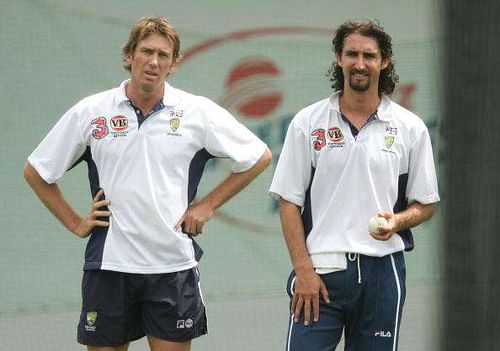
Watch: Team-mates and opponents reveal what made Glenn McGrath and Jason Gillespie special
(Video courtesy: Lord’s Cricket Ground’s official Youtube account)
Whilst reminiscing on some of the dangerous fast bowling pairs in the game’s history, the combination of Glenn McGrath and Jason Gillespie might fly under the radar. With the former merging with Shane Warne to form a dominant seam/spin duo, his collaboration with the latter does not evince as many eyebrows as it should. After all, they often took the new ball for one of the greatest teams ever and set the tone by getting into the psyches of opposition top orders.
In a video posted on Lord’s Cricket Ground’s official Youtube account, acclaimed team-mates of the duo, as well as distinguished opponents, shared their insights into the McGrath/Gillespie alliance which racked up heaps of wickets.
Former England opener Marcus Trescothick, who has plenty of experience in tackling both seamers, feels, “Facing Glenn McGrath and Jason Gillespie was very, very tricky. They are similar yet different in their own unique ways. I always found (that) Gillespie did me on pace as the ball almost traveled an extra yard fuller. At that time with the team that they had, they mad it very, very difficult for opening batsmen.”
The duo played 58 Tests together and gobbled up 484 wickets between them with as many as 23 five-wicket hauls. While McGrath picked up 274 of those at an average of 20.52, Gillespie accounted for 210 scalps at an average of 26.27. They participated in three successful Ashes campaigns in tandem with two of those coming away from home. Interestingly, in those 58 Tests, Gillespie's tally cost fewer runs and came more frequently than even Warne.
Also read: Glenn McGrath - The story of the boy who couldn't bowl
Iconic Pakistani pacer Wasim Akram, who himself knew a thing or two about hunting in pairs, quips, “Glenn McGrath (was) definitely one of the best bowlers I have seen. He wasn’t a swing bowler but he knew the weakness of a batsman in a matter of split-second. His line was immaculate and length was consistent. That’s why he brought 500-600 (563) Test wickets because he was one of the best of all-time, in my book.”
An integral part of the all-conquering Australian side
Aside from their three successive World Cup triumphs (in 1999, 2003 and 2007), Australia also ruled the roost in the Test arena for most part of the late 90s till mid 2000s. While their batting lineup rarely failed to pile on massive scores on board, the variety in the bowling attack was one of the major reasons behind their ruthlessness. With McGrath putting opposition batsmen under a thorough examination of technique and temperament, Gillespie extracted bounce from an awkward length which forced them to prod at even good-length deliveries.
Among the Aussie skippers to enjoy their presence, Ricky Ponting believes, “When he (Gillespie) actually first started, he was as quick as anyone around and bowled well over 90 miles an hour. He was probably the more of an out and out wicket-taker while McGrath was a container and built more pressure on batsmen. Gillespie could run in and do that (as well) and also had the ability to bowl some balls that just got great players out. Those two certainly should be remembered as one of Australia’s great opening bowling combinations.”
Ponting’s deputy and trailblazing wicket-keeping batsmen Adam Gilchrist points to their relentlessness by alluding, “(There was) one spell in Hobart against New Zealand which not many people would recall the ruthlessness. They might have had a crack at Stephen Fleming, the New Zealand for not being more attacking and moving the game forward – only to turn around and laugh, ‘Mate, you come and have a go.’”
Also read: Why do Australia consistently produce the fastest bowlers in the world?
After Australia had cruised to 558 in the first innings, the Kiwi batsmen treaded cautiously in an effort to test their patience. Despite the frequent rain interruptions, McGrath and Gillespie did not veer away from giving it everything. Eventually, the match ended in a draw with New Zealand crawling to 243/7. This was a fine example of their tenacity in terms of constantly striving for victories irrespective of the circumstances.
In a self-effacing manner, Jason insists, “It was perfect for me to have someone like Glenn at the other end. You knew that the opposition batsmen would look at the bowling combination and be like, ‘We might have a piece of this Gillespie bloke’. I felt that gave me opportunities to take wickets.”
McGrath ended his career with 563 wickets from 124 Tests at an average of 21.64 and strike-rate of 51.9. Only the three legendary spinners Muttiah Muralitharan, Warne and Anil Kumble have more wickets to their names than ‘Pigeon’. Meanwhile, Gillespie finished with 259 wickets from 71 Tests at an average of 26.13 and strike-rate of 54.9. Though his numbers may not be as illuminating as his partner-in-crime, ‘Dizzy’ played a vital role as well in their extremely valuable partnership.
